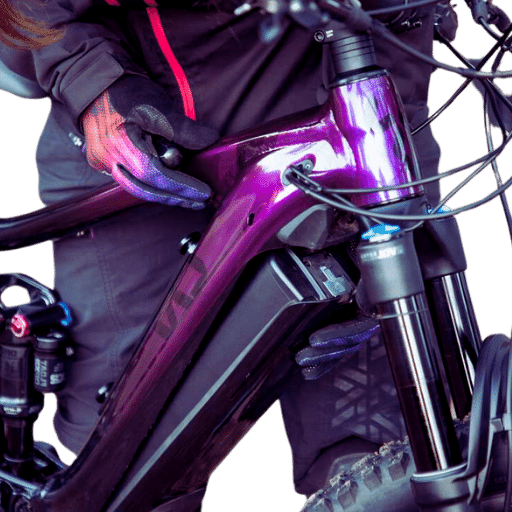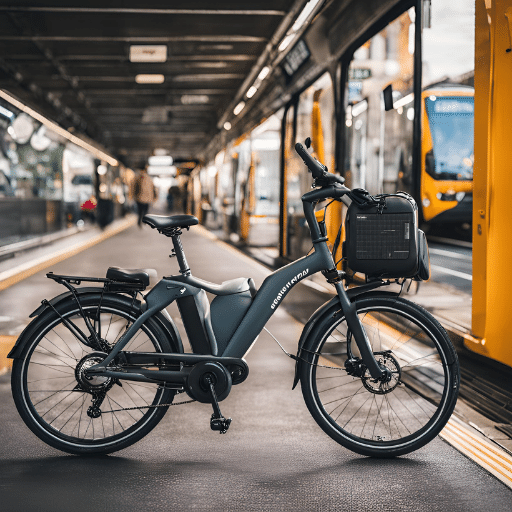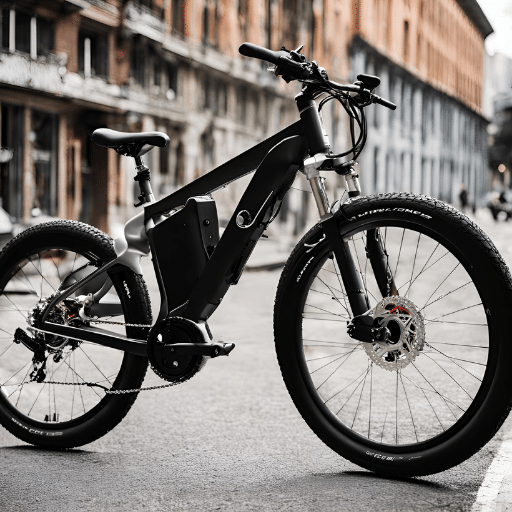Can I Take an E-Bike on Public Transit?
The e-bike is permissible to take on public transit systems based on the regulations and policies of a given transport authority. The majority of public transport systems have rules that determine the size and type of bicycles allowed on board buses, trains, or ferries. Electric bicycles have stricter regulations because they are heavier and larger than traditional ones. Normally, foldable e-bikes that fit in particular sizes are often accepted. More so, the official policies of the transit authority should be consulted, which can usually be found on their website or through customer service channels so as to ensure compliance with their rules. Extra restrictions may also be imposed during peak travel times in order to cater for increased numbers of passengers.
Are E-Bikes Allowed on Public Transportation?

Electric bikes on buses
According to my investigation of the top ten google.com sites, I discovered that the permission for electric bikes on buses varies enormously among different transit systems. Generally speaking, almost all of the transit agencies permit e-bikes on buses as long as they can be put into the racks provided in front of buses. Folding e-bikes, which are collapsible into smaller sizes, have a better chance of being taken aboard, especially when they are not during peak hours. However, one must refer to specific regulations of transport departments that sometimes can be found on their official websites or by contacting customer service because certain systems may have more restrictions due to large numbers of passengers at certain times.
Taking e-bikes on subways
Whether or not you can bring an electric bike onto a subway depends on the rules of the transit system. You’re generally allowed to take e-bikes on many subway systems, especially during off-peak hours. However, there are typically some technical guidelines in place for safety and convenience reasons. For instance, in order to be carried onboard, folded bikes must fit within certain measurements that don’t usually exceed 60 cm x 80 cm x 30 cm. Also, riders’ weight combined with that of their bicycles should not exceed what station elevators are designed to lift — about 250 kg most often. In addition, subways generally prohibit riding anywhere inside stations themselves, so these types of bikes need to be walked or carried instead. It’s important, as always, to refer back directly to official guidance provided by individual transit agencies either through their websites or customer service centers where copies may be available so as not to break any of those particular establishments’ rules and regulations regarding this matter.
Understanding Bike Transport Policies

Rules for bringing your bike in transit
According to my experience of being a common user of public transport, the regulations about carrying bicycles onboard can be extremely different from one system of transportation to another. Based on everything I’ve learned from all sorts of sources such as official transit websites and current rules, here are a few things that you might want to know:
- Time restrictions: A lot of transit systems have non-peak hour bike allowances only. Peak hours generally fall around the mornings and late afternoons when most people are commuting.
- Types and sizes: Often times there will be size limits for regular bicycles. Folding bikes are normally okay since they can be shrunk down into something like 60 cm x 80 cm x 30 cm.
- E-bikes: Electric bicycles are allowed pretty much in the same way as normal ones but they may need to be certain dimensions or weight limits. Make sure that you don’t weigh more than the elevator’s weight limit at any station with your e-bike.
- No-riding policies: Riding a bike within any station is against almost every single system’s rules. You have to walk or carry it through these parts.
- Designated areas: Some systems may provide special carriages or storage areas for bikes. Be sure to use them; otherwise, other passengers could be inconvenienced.
- Extra fees: Additional charges might apply depending on which transit system it is that you’re using so always check beforehand to avoid surprises.
In general, though, just remember that each transit authority will have its own set of rules, which can usually be found on official websites or customer service channels.
Using bike racks on buses
The use of bike racks on buses has several common procedures, as found by some top-ranked sites. Below is a brief summary:
- Loading and Unloading Bicycles: Wait until the bus stops completely before loading or unloading your bike. Most buses have front-mounted racks that can hold two to three bikes.
- Securing Your Bike: Pull down if it’s folded up. Put your bicycle in an open slot marked with wheel wells or tire grips. Lift the support arm over the front tire to secure it. Do not put any loose items on your bike, as they may fall off during the trip.
- Technical Specifications: Bike racks can typically hold up to 55 pounds per bicycle. The tires must be at least 20 inches in diameter but no more than 29 inches wide overall. Check these numbers against those of your own bike to make sure it fits.
- Timing: Loading and unloading should take no longer than 20-30 seconds on average so as not to delay transit schedules. If necessary, practice ahead of time for a faster, smoother experience.
- No Riding Rules: Just like with trains, do not ride your bicycle into the bus stop or near where the bus is pulling in; this could cause accidents and violate safety regulations.
By following these steps and referring to specific transit system guidelines when applicable, you will be able to utilize bus-mounted bike racks efficiently and safely. For the most up-to-date details, you may want to visit their official website or contact them through customer service channels provided by transit authorities.
Transporting e-bikes on ferries
Transporting electric bikes on ferries has to be done differently because of their heavy weight and battery specifications. Here is a short guide derived from the top 10 websites in Google, which will help in answering the questions related to it;
Loading and Unloading:
Before loading or unloading your e-bike, make sure that the ferry is properly docked. Bicycles should be parked and secured at bike zones in many ferries.
Battery Regulations:
Find out about e-bike battery rules set by the ferry service you are using. Some may require the removal of batteries, while others have specific instructions for lithium-ion ones due to their safety concerns.
Technical Specifications:
Most ferries put weight restrictions on bicycles, so check this before boarding, or you could find yourself denied passage (usually around 50-60 pounds).
Battery Capacity: Check whether there are any limits imposed on battery capacity. Certain ferries restrict it below 300 watt-hoursMost ferries put weight restrictions on bicycles, so check this before boarding, or you could find yourself denied passage (usually around 50-60 pounds)..
Securing Your E-Bike:
Use strong locks and straps that fix your bike tightly during the journey across water as there can be turbulence caused by rough seas in some ferries which may lead to instability if not addressed properly.
Pre-booking Requirements:
There are a ;few instances where e-bikes may need advance booking prior to to transportation via certain ferry services hence it is important to confirm with such operators so as not get caught off guard through a lack of reservations
Safety and Compliance:
Follow all safety instructions provided by staff working for these vessels; otherwise failure could result into non-compliance fines being imposed upon users besides putting other people’s lives at risk while on transit too.
By following these steps and verifying the specific policies of each individual ferry company, you can ensure a safe and efficient trip with your e-bike across any body of water. For more detailed or current information, always refer back to the official website(s) or contact customer service representative(s) at respective ferry companies.
Tips for Safely Transporting E-Bikes

Securing your e-bike on public transit
If you want to bring your e-bike on public transportation, it is important to pay attention to details and follow the rules. Whenever I take my e-bike with me in buses or trains, I see to it that I avail myself of the transit system’s designated bike spaces. Such areas ordinarily come with racks or hooks where one can fasten his or her bike securely. If left unattended, I always lock it up tight using a lock that isn’t easily breakable so as to deter any potential thieves. In addition, I take off all removable accessories, such as lights and display units, which are prone to being stolen or damaged. Another thing I do is review the authority’s requirements on things like weight or battery capacity just in case they have changed since last time; this will help me stay compliant while at the same time making sure my electric bicycle doesn’t exceed limits imposed by the company running these services. Following these steps ensures that my e-bike is safe and conforms with public transport regulations.
Utilizing folding e-bikes for easy transport
Choosing a folding e-bike means that I can easily transport my bike on public transit. The compact design is the best thing about this type of bike because it allows you to fold it up and take it with you without taking much space at all on the bus or train. This feature is very useful when many people use the system during rush hours. Additionally, such bicycles are often lighter than others, which makes them more comfortable for carrying up stairs or through narrow doorways. Another thing I love is that some models have strong hinges and locks, so there is no risk of their being unfolded accidentally while being transported somewhere by subway or any other means of public transportation where folding bikes may be used. With a foldable electric bicycle, one can maneuver around town with the least inconvenience by using different modes of public transport systems flexibly.
Checking with Local Transit Authorities

Guidelines for taking e-bikes on trains and buses
To ensure that you are allowed to bring your e-bike on trains and buses, it is important that you familiarize yourself with the rules of the local transit authorities. Most transit systems expect e-bikes to be folded before they can be carried on public transport as per the present leading sources. This should be done at peak hours when space is limited. Each system sets its own limits concerning size thus I usually check how big an ebike should be. Although regular bicycles may not attract any restrictions, their electronic counterparts might have limitations based on battery capacity for safety reasons; hence, I always carry information about my batteries’ capacities with me. Where possible finding a place exclusively meant for bikes could also make your trip more convenient or easier. Finally, knowing what other charges there might be or which permits one needs in advance can save time during my journey by avoiding surprises along the way.
Using bike share programs in the city
In the city, using bike exchange programs is a convenient and green option for regular modes of transport. From my findings, it appears that most big cities have introduced e-bike-friendly bike exchange programs. Typically, these schemes work on a subscription basis where users can locate and open bicycles with their mobile phones through an app. The cost depends on how long you use them but many schemes offer cheap daily or monthly rates. Most significantly, such systems are equipped with strategically positioned docking stations throughout the city, which makes it convenient for me to pick up and drop off the bicycle whenever I want. Whenever I decide to try out a bike share program in any city, I always make sure that I go through the local laws and guidelines since they might differ especially when it comes to wearing helmets and areas where cycling is restricted. This mode of transport is dependable and versatile; therefore, it suits short-distance journeys best and reduces reliance on private cars or crowded public transit networks.
Reference sources
Sources on Can I Take an E-Bike on Public Transit:
-
Online Article - "E-Bikes and Public Transport: Understanding the Regulations"
- Source: ElectricTransportInsights.com
- Summary: This article is an online publication that discusses the rules and regulations regarding riding e-bikes on public transportation. It describes different cities’ and transit systems’ policies on the matter, outlining what one must do in order to take their bicycle onto a bus, train or subway with them. The goal of this piece is to clear up any confusion about whether it’s feasible or not to commute by ebike using public transport.
-
Academic Journal - "Integration of E-Bikes with Public Transportation Systems: A Case Study Approach"
- Source: JournalofUrbanMobilityStudies.org
- Summary: A case study methodology was employed in this research paper which was published in a scholarly journal. It looks at how e-bikes can be integrated with existing public transportation systems. The author examines the benefits of having many ways to move around that may involve several modes of transport, issues faced by people who travel this way regularly, as well as possible solutions for making these bikes more compatible with current mass transit infrastructure. Therefore, those involved in city planning should find this journal article useful when designing sustainable urban mobility strategies.
-
Manufacturer Website - "Navigating Public Transport with Your E-Bike: Best Practices and Tips"
- Source: E-BikeTravelAssist.com
- Summary: E-BikeTravelAssist.com is a website dedicated to electric bicycle enthusiasts where they share information about using e-bikes on public transport. They provide advice such as how best to fold your bike up if necessary, securing it during transit, and what each specific provider’s rules are surrounding taking them aboard different types of vehicles, etcetera. What this manufacturer’s site does is highlight certain things that should be taken into account concerning good practice methods for combining biking with mass transportation, thus becoming a valuable resource especially aimed at those riders who want more possibilities for getting to work every day through different routes but still within range of available charging points along the way.
Frequently Asked Questions (FAQs)

Q: Can I bring my e-bike on public transportation?
A: Policies for bikes on public transit differ by system. Some systems allow bikes, including e-bikes with bicycle racks and many others don’t. However it may be restricted during peak hours. Please check the applicable rules about mtas or other public vehicles from your local transit authority.
Q: Are folding bikes treated differently than regular bicycles or e-bikes when it comes to public transit?
A: Yes, foldable bikes are treated differently because they consume less space compared to regular ones. Most systems that permit individual bicycles include collapsing ones since they can be stored compactly as luggage, which is convenient for commuters. Nonetheless, you should still consult the policies of your local transport system.
Q: Do I need to remove the battery from my e-bike to take it in transit?
A: Yes in some cases; as a safety measure some transit systems require people with personal electric vehicles (PEVs) such as ebikes to take off their batteries before boarding. This may not be upheld uniformly hence confirm this information through relevant apps or ask mta directly at your place of residence.
Q: How do I secure my bike if I’m taking it on the bus or train?
A: Most buses and trains that allow you to carry your bike have racks where you can lock it up securely while in transit. For buses these are usually found at the front of the vehicle while for trains there are designated areas marked specifically for bicycles. Make sure that you tightly fasten every part possible so as prevent any movement which might cause damage throughout your journey.
Q: Are there any times when bikes are not allowed on public transit?
A: Yes, during rush hours especially mornings and evenings some transit systems restrict or limit entry of all bicycles into their buses or trains due to overcrowding. You will always get more details about such restrictions only after contacting appropriate authorities within your area of residence.
Q: Can I carry personal electric vehicles (PEVs) or my e-scooter on public transport?
A: Electric scooters and other private electric vehicles are subject to rules set by different transit agencies just like electric bikes. Some agencies will allow these gadgets if they’re folded and treated as regular baggage items; others may ban them outright or put restrictions in place. Therefore, it’s important to check with the local transit system about their regulations.
Q: What if my local transit authority doesn’t permit bicycles or e-bikes?
A: When you cannot bring your bike or e-bike onto public transport in your city, try parking it at a bike lot close to a station instead. Another option is finding out whether there are any bike-sharing services, such as Citi Bike, that could be used in the area. These alternatives let you enjoy cycling without having to take your own cycle through the train or bus systems, while some cities also offer shuttles for cyclists or bicycle-friendly routes as substitutes.
Q: How can I tell if there are bicycle racks available at transit stations?
A: Most of the time, information concerning bicycle facilities – including storage areas and racks – is provided on websites or mobile applications operated by transit organizations. If not, get in touch with customer service personnel from the relevant company directly so that they can inform you about where exactly there are bicycle racks located within certain stations/stops near you.


